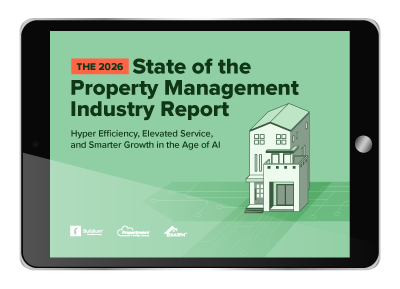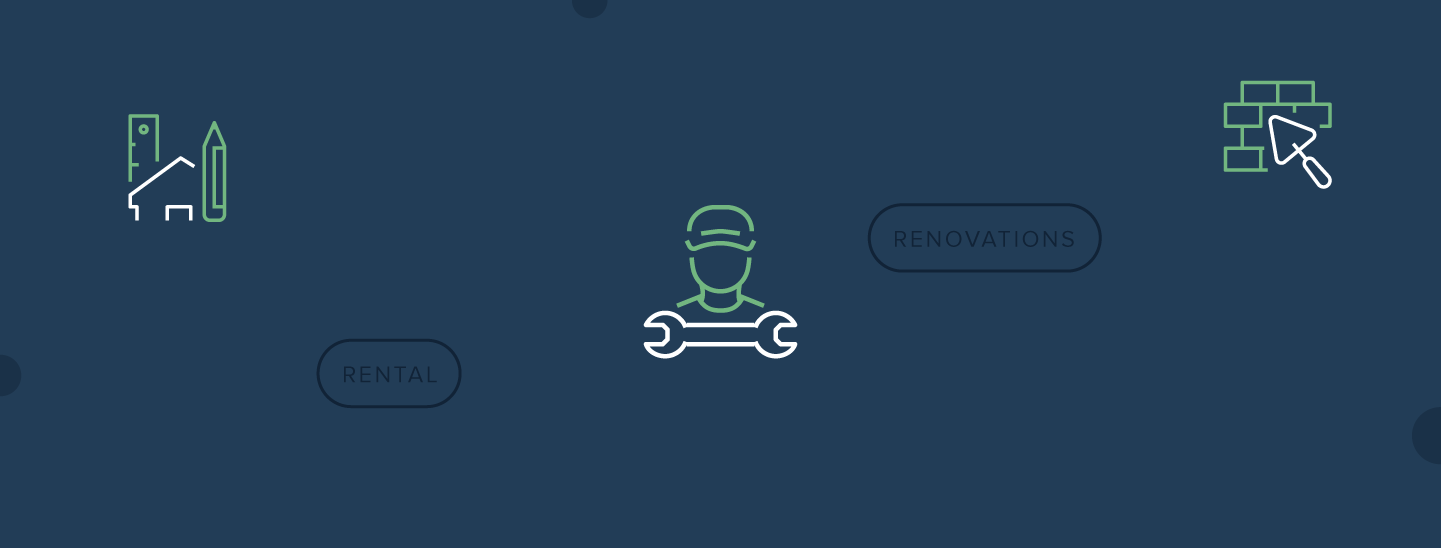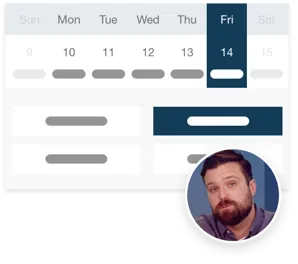Rental property renovations are one of the most effective ways property managers and owners can improve the long-term value of their properties and the revenue they bring in. From modern finishes that attract new tenants to upgrades that cut maintenance costs, thoughtful improvements keep each unit in your portfolio competitive.
Automated Maintenance
Track every maintenance request, schedule repairs, and pay vendors all in one place.
Learn MoreIn this guide, you’ll learn how to set goals, plan budgets and timelines, navigate compliance, select projects that pay off, and manage vendors and quality from kick‑off through lease‑up.
How to Approach Rental Property Renovations
Before you price a single project, get clear on your “why.” This section sets the foundation so every decision supports your business goals.
Defining Your Renovation Goals
Start with outcomes, then work backward. Broad goals you’ll want to keep in mind include increasing rent, cutting ongoing maintenance, reducing vacancy days, decreasing energy costs, and improving resident experience. Choose two or three that matter most to owners and to your team.
From there, translate each goal into a measurable KPI. Some examples could include:
- +$125 average rent
- −20% work orders tied to old appliances
- 2 days faster turn
Pro Tip: Tie every scope item to a KPI that’s relevant for your business and its growth. If a line item does not move a KPI, it probably does not belong in phase one. You can read more on identifying the right KPIs here.
Planning Your Renovation
A plan that blends assessment, budgeting, and scheduling will keep your project on track. Here’s how to go about each step, so you’re not left blindsided by unexpected costs or repairs.
Conducting a Property Assessment
Document current condition with photos and notes before you request bids. Include:
- Health and safety risks that must be handled first
- Systems: roof, HVAC, plumbing, electrical
- Unit finishes: kitchens, baths, flooring, paint, lighting
- Curb appeal: exterior paint, landscaping, signage, parking
- Energy and water: windows, insulation, fixtures.
When assessing your properties, use a repeatable checklist so you can compare properties apples to apples. Capture resident feedback patterns from maintenance tickets to uncover quick wins
Setting a Budget
Build a bottom‑up budget with three columns: scope, unit cost, and contingency. Typical contingency ranges from 10% for light touch projects to 20% for heavy CapEx or older buildings.
Include soft costs such as design time, permit fees, inspections, temporary housing or rent credits if tenants remain in place, and marketing for the upgraded units.
Be sure to also frame your budget in terms of ROI, using clear formulas like this:
- expected rent lift × months to stabilization minus total project cost
Accounting Tip: Set budget categories that match your chart of accounts so actuals roll up cleanly later.
Creating a Timeline
Work backward from your target “first unit leased” date. Add milestones for:
- Final scope and budget sign‑off
- Permit submission and expected approval window
- Long‑lead material orders (appliances, windows, cabinets)
- Start and finish dates by trade
- Punch walks and final inspection.
Be careful not to set a timeline that’s overly ambitious or unrealistic. Add buffer time between trades to avoid crowding, and build in time for inspections. Once it’s ready, consider sharing your timeline in a Gantt chart or calendar that everyone on your team can access to stay on the same page.
Legal and Regulatory Considerations
Renovations introduce compliance risk. Plan for code, permit, and resident notification responsibilities before work begins.
Disclaimer: This section offers general information for educational purposes. Always consult a licensed attorney and local authorities for guidance specific to your jurisdiction and property type.
Understanding Local Building Codes
Codes vary by municipality and often update on a predictable cycle. Identify code triggers in your scope. These can include things like replacing a water heater, upgrading electrical panels, adding outlets, moving walls, window replacements, or changing egress. Ask inspectors early about gray areas to avoid surprises.
Permits and Approvals Needed
Create a simple permitting matrix by project type and city. Track submission dates, fees, and review timelines. When possible, batch similar permits for multiple units to save time.
Tenant Rights and Notification
If residents will be present during work, plan quiet hours, access windows, and temporary accommodations for disruptive tasks. Provide written notices with who to contact, work hours, and safety instructions. If units will be vacant during construction, update lease language and showing policies accordingly.
Choosing the Right Renovations
Of course, you’ll have to pick and choose the projects that give your portfolio the most value. These are usually projects that balance rent lift, durability, and long‑term savings. Here are some popular options:
High‑Impact Renovations to Increase Rental Value
- Kitchen refreshes: cabinet painting or refacing, modern pulls, mid‑range appliances, durable counters, updated faucet and lighting
- Bathroom upgrades: new vanity, water‑saving fixtures, bright lighting, fresh tile surround or quality surround panels
- Curb appeal: exterior paint touch‑ups, clean signage, landscaping, power washing, secure mail areas, bike storage
- Amenity add-ons: in‑unit laundry where possible, smart locks, package lockers, pet‑friendly areas
Cost‑Effective Renovations to Lower Maintenance Costs
To keep your units low-maintenance, focus on items that reduce tickets and extend life.
Kitchens and Bathrooms: Swap aging disposals, leaky faucets, and stained caulk. Use water‑resistant wall panels in splash zones. Choose mid‑grade fixtures with easy‑to‑source replacement parts.
Flooring and Walls: Use LVP or tile in high‑traffic areas. Reserve carpet for bedrooms only, or remove it entirely. Prefer light, washable wall colors and semi‑gloss in kitchens and baths.
Energy‑efficient Upgrades: Prioritize LED lighting, smart thermostats, aerators, and low‑flow showerheads. Consider insulation, window sealing, or replacements in buildings with high utility bills. These cut costs and can serve as a marketing hook for eco‑conscious renters.
Hiring Contractors and Vendors
The success and cost-effectiveness of any job ultimately comes down to the skill and professionalism of the people working on it. Take the time up front to build relationships with vendors and contractors you can trust, following these guidelines:
Find Reliable Professionals
Build a preferred vendor list before you need it. Ask for proof of licensure, insurance, and W‑9s in your vendor onboarding. Request three references and photos of recent work in similar buildings and price points.
Compare Quotes and Negotiating Contracts
Issue a clear scope of work and a product schedule so quotes are comparable. Evaluate bids on total price, lead times, payment schedule, and workmanship warranty. Negotiate progress payments tied to milestones and renegotiate until final punch items are complete.
Manage Contractor Relationships
Hold weekly check‑ins that cover progress vs timeline, change requests, and upcoming access needs. Share a single source of truth for schedules, plans, and decisions. Follow up in writing after every meeting.
Managing the Renovation Process
Having a disciplined review process keeps small issues from becoming expensive delays. Use a shared calendar for all trades. Track start and finish dates and note blockers. When a task slips, immediately resequence downstream activities and notify vendors.
You should also create a punch list template for each trade. Schedule internal rough and final walks before city inspections so you can fix problems once. Document with photos.
Expect some surprises. Keep contingency funds separate, log every scope change with a cost and schedule impact, and communicate promptly with owners. If a discovery changes your ROI, decide whether to pause, phase, or value‑engineer.
Budget Management
Great projects can still miss their financial targets without active cost tracking. Code every invoice to the right category and property. Reconcile weekly against budget. Share a red‑yellow‑green status dashboard with owners so there are no end‑of‑project surprises.
When you dip into contingency, try to offset by descoping lower‑value items. Capture final actuals and lessons learned to improve estimates next time.
Post‑Renovation Considerations
Closing strong helps you capture the rent lift you planned for. Keep inspection sign‑offs and warranties in your property records. If scope triggers updated disclosures or certificates, file and store them where staff can find them fast.
Do a final clean, change filters, label shutoffs, and restock touch‑up paint. Provide a welcome sheet with appliance guides and maintenance contact details.Be sure to also update listing photos, highlight upgraded features and projected utility savings, and refresh your amenity list. Consider a small launch incentive for the first leased unit to restart occupancy quickly.
Software for Faster and More Cost‑Effective Rental Property Renovations
Managing renovations is easier when all your processes run through a single platform. Comprehensive property management software such as Buildium, comes with a few major benefits:
- You can manage every work order, from request to completion, in a central hub and from any device, with the ability to upload photos, documentation, and other details as needed
- You can centralize communication in a resident portal, where you can store important documents, keep records of past requests and conversations, and even set up automated messages and notifications.
- You can record all maintenance-related transactions like vendor invoices in a neat, transparent system that’s linked to the rest of your accounting records. This simplifies everything from filing taxes to generating reports and performance analytics. It’s all taken care of in-platform.
- If you want to keep your properties and tenants covered at all times without giving your team extra work, you can use Buildium’s Maintenance Contact Center, a service that fields maintenance requests 24/7/365 and routes them to the right vendors for completion, while giving you full visibility every step of the way.
In addition to comprehensive property management software, you can also invest in more specific tools such as Property Meld for setting up automated maintenance workflows or Inspectr for smart diagnostics to make work order management more efficient.
How to Kick Off Your Renovation Projects
Renovations can feel overwhelming, but when supported by clear goals, careful planning, and the right technology, they become a powerful way to add value across your portfolio.
With purpose-built tools, property managers gain greater visibility, better communication, and smoother coordination. The result? Your projects deliver measurable returns and a better experience for tenants and owners alike.
Key takeaways:
- Start with goals tied to KPIs, then scope and budget to match
- Build a permitting and inspection plan early
- Choose projects that balance rent lift with durability and energy savings
- Vet vendors carefully and track timeline, quality, and cost weekly
- Use software to coordinate tasks, control spend, and keep residents informed
If you’re ready to put your 2026 maintenance plan into action, start by building your software toolkit. Buildium makes finding the right tools for the job easy with a no‑risk 14‑day free trial and live, guided demo so you can start coordinating all your property management tasks on a single platform.
Frequently Asked Questions
Can I write off renovation expenses on a rental property?
Tax treatment depends on whether work is considered a repair (often deductible in the year incurred) or a capital improvement (often depreciated). In many cases, repairs that maintain the property’s current condition can be written off immediately, while upgrades that extend useful life must be capitalized. Always talk with a licensed tax professional for guidance specific to your situation and jurisdiction.
What are the key considerations for property managers when planning a rental property renovation?
Define goals and KPIs, assess current condition, build a realistic budget and timeline, plan for permits and tenant communication, and select durable, mid‑grade materials that fit your renter profile. It also helps to consider seasonality—renovating during slower leasing months can minimize vacancy loss.
How can property managers budget effectively for renovations and avoid unexpected costs?
Use line‑item budgets, include a contingency (10–20%), order long‑lead materials early, and review actuals weekly. Log change orders with cost and schedule impact. Consider getting multiple quotes for larger items such as appliances or flooring, and lock in pricing when possible to hedge against inflation.
What are the best strategies for minimizing tenant disruption during renovation projects?
Provide written schedules, limit noisy work to set hours, bundle invasive tasks, offer temporary accommodations for major disruptions, and communicate through the Resident Center. Some property managers also offer small rent credits or amenities such as free laundry vouchers as goodwill gestures when projects affect daily life.
How do property managers stay compliant with local building codes and regulations during renovations?
Create a permit matrix by project type and city, schedule pre‑inspection conversations when the scope is complex, and keep all approvals and inspection reports with the property’s records. Regularly check for code updates, since municipalities often revise standards every few years.
What are the most valuable renovations that can increase the rental value of a property?
Kitchens and baths, in‑unit laundry where feasible, durable flooring, energy‑efficient fixtures and lighting, and curb appeal improvements often deliver strong returns in most markets. In competitive neighborhoods, adding modern amenities such as smart locks, bike storage, or package lockers can also be differentiators.
Should I renovate occupied units or wait until they are vacant?
Whenever possible, it is easier and faster to complete renovations when units are vacant. However, for small upgrades or emergency work, you may need to coordinate access with tenants. In those cases, provide clear schedules, minimize downtime, and consider offering incentives for tenant cooperation.
Read more on Maintenance

